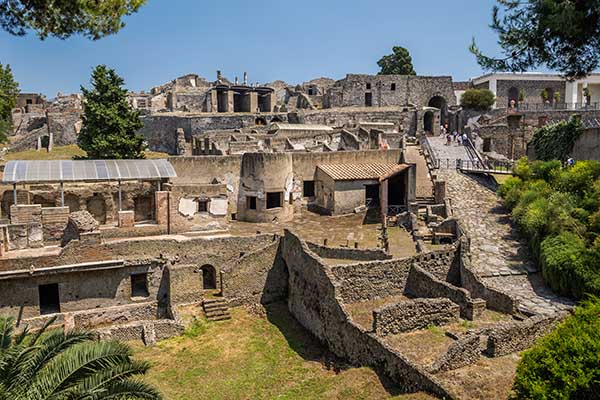Exploring the Fascinating History of Pompeii
Have you ever imagined being transported back in time to witness an ancient city at the peak of its glory? Well, if you're a history buff, you're in luck because we're about to take you on a journey to Pompeii, a city frozen in time. Located in the Campania region of Italy, Pompeii was a vibrant Roman city that was buried under tons of volcanic ash and pumice after the catastrophic eruption of Mount Vesuvius in AD 79. Let's explore the fascinating history of this ancient city and what makes it so captivating to this day.
Life in Pompeii before the eruption
Before the eruption, Pompeii was a bustling city with a population of around 20,000 people. The city was located near the Bay of Naples and was a major trading center. The fertile land surrounding the city made it an ideal location for agriculture, and Pompeii was known for its wine, olive oil, and other agricultural products. The city was also a popular vacation spot for wealthy Romans who came to enjoy the beautiful beaches and warm climate.
The city was home to some of the most magnificent buildings of the Roman era, including public baths, amphitheaters, and temples. The city's architecture was a blend of Greek and Roman styles, and many buildings were adorned with intricate frescoes and mosaics.
One of the most fascinating aspects of Pompeii is the way that the city was preserved. When Mount Vesuvius erupted, the city was covered in ash and pumice. This ash acted as a natural preservative, and many buildings and objects were perfectly preserved under the layers of volcanic material.
Rediscovery of Pompeii
Pompeii remained buried under the ash and pumice for almost 1700 years, until it was rediscovered in 1748. The rediscovery of Pompeii was one of the most significant archaeological discoveries of all time. Excavations of the city began in the mid-18th century and are still ongoing to this day.
The excavations have revealed a treasure trove of information about life in ancient Rome. The buildings and objects that were preserved under the ash give us an unparalleled glimpse into the daily life of Pompeii's inhabitants. From the frescoes and mosaics that adorned the walls of their homes, to the graffiti scrawled on the streets, Pompeii offers a unique insight into the ancient world.
What to see in Pompeii
Today, Pompeii is one of the most popular tourist destinations in Italy. Visitors from all over the world come to see the city frozen in time. There are many things to see in Pompeii, and a visit to the city can easily take a full day or more.
One of the must-see sites in Pompeii is the Forum, the city's central square. The Forum was the center of political and social life in Pompeii, and many important buildings were located there, including the basilica, the temple of Apollo, and the courthouse.
Another popular site in Pompeii is the amphitheater. The amphitheater was the site of gladiatorial games and other spectacles. It's a large, impressive structure that could hold up to 20,000 spectators.
One of the most fascinating things about Pompeii is the way that the city's inhabitants left their mark on the city. The streets of Pompeii are covered in graffiti, much of it surprisingly modern in its content. Visitors can also see the remains of shops, bars, and restaurants that were once bustling with activity.
Perhaps the most striking aspect of Pompeii is the way that the city's inhabitants were caught in the midst of their daily lives by the eruption of Mount Vesuvius. Many of the houses in Pompeii still have their original furnishings, including beds, chairs, and tables. Visitors can also see the remains of food and drink that were left behind when the inhabitants fled the city.
One of the most popular sites in Pompeii is the House of the Vettii, a wealthy family's home that has been remarkably preserved. The house is adorned with intricate frescoes and mosaics, and visitors can see the bedrooms, dining rooms, and courtyards of the ancient family.
Another must-see site in Pompeii is the Pompeii Archaeological Museum, which houses many of the artifacts that have been discovered during the excavations. The museum offers an in-depth look at life in Pompeii before the eruption of Mount Vesuvius.
Visiting Pompeii
If you're planning a visit to Pompeii, there are a few things to keep in mind. The city can get very crowded, especially during peak tourist season, so it's a good idea to arrive early in the morning to beat the crowds. Comfortable shoes are also a must, as the streets of Pompeii are made of uneven stones.
It's also a good idea to hire a guide or audio guide, as there is so much to see in Pompeii that it can be overwhelming without some guidance. A guide can help you make the most of your visit and give you insights into the daily life of Pompeii's inhabitants.
Final thoughts
Pompeii is a city frozen in time, a testament to the power of nature and the endurance of human civilization. The city's remarkable preservation has given us an unparalleled glimpse into the daily life of ancient Rome, and a visit to Pompeii is a must for anyone interested in history.
Whether you're fascinated by the architecture of ancient Rome or intrigued by the daily life of Pompeii's inhabitants, there's something for everyone in this ancient city. So why not plan a trip to Pompeii and experience the history and beauty of this remarkable city for yourself?
Labels: Interesting, travel


0 Comments:
Post a Comment
Subscribe to Post Comments [Atom]
<< Home